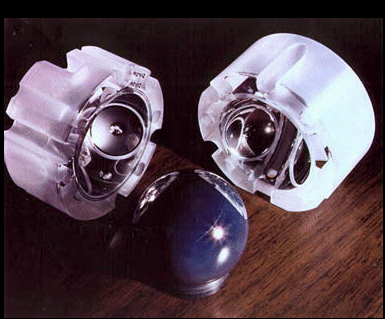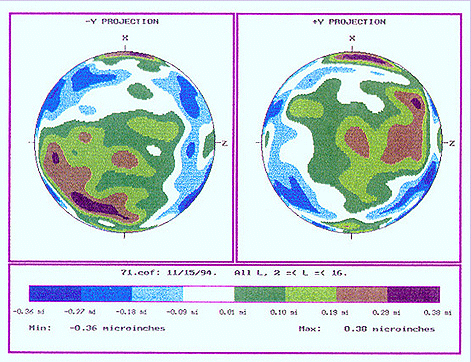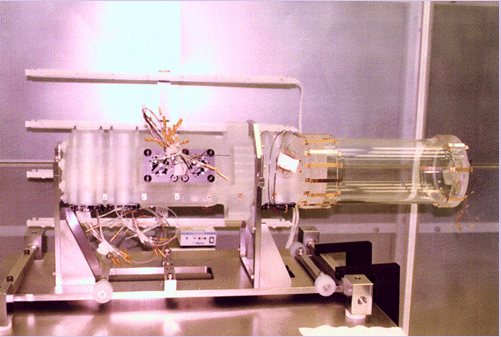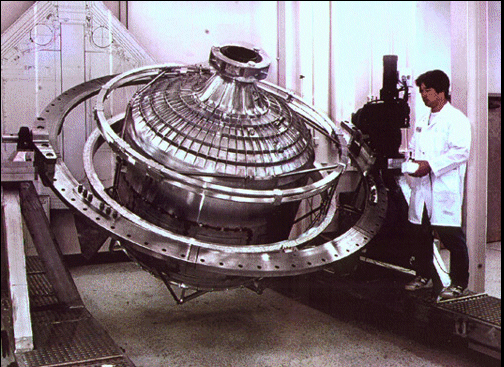Gravity Probe B

The GP-B flight gyroscope is a sphere of fused quartz, 1.5 inches (38 mm) in diameter. It is electrically suspended by applying voltages to the saucer-shaped electrodes seen in the two halves of the housing. It is spun up to 170 Hz by gas running through the circumferential channel visible in the right-hand hemisphere, after which the gas is pumped out and the ball runs freely in a vacuum. The direction is read out by a SQUID connected to the superconducting circuit on the face of the left-hand hemisphere.
When Gravity Probe B is launched in October 2002 into a 400-mile-high polar orbit for a 18-24-month mission, the instrument apparatus will measure tiny changes in the directions of spin of the four ultra-precise gyroscopes contained within. The gyros will be so free of disturbances that they will provide a nearly perfect space-time reference system. They will be coupled to an onboard telescope that will sight on a far-field highly stable reference star.
In 1960, Professor Leonard Schiff of Stanford University suggested that a set of nearly perfect gyroscopes in Earth orbit could check two extraordinary consequences of Albert Einstein’s theory of General Relativity. Einstein’s theory, put forth in 1915, provided a completely new understanding of gravity, replacing the theory Newton had advanced in 1687. Newton saw gravity as an attractive force acting instantaneously at a distance across space to affect all bodies. Einstein proposed instead that space, time and matter are not independent of each other, as Newton had assumed. Gravity acts not as a force but as a field that warps space and time around massive bodies such as stars and planets.
Like most other fields of science, Einstein’s theory of gravity, the general theory of relativity or GR, has developed its own notation and jargon. Despite the simplicity and economy of its underlying assumptions, the theory in full glory leads to intensely complicated nonlinear equations. Indeed, the equations have been fully solved only in a few special instances. However, much of the mathematical complication can be removed by assuming that all gravitational fields are weak. The equations then reduce to a form remarkably similar to those governing electromagnetism. Terms appear that are analogous to the electric field caused by charges (the gravitoelectric field, produced by masses), and to the magnetic field produced by the flow of charge (the gravitomagnetic field, produced by the flow of matter). A spinning ball of electrical charge produces a well-prescribed static magnetic field, and correspondingly a spinning mass such as the Earth is expected to produce a static gravitomagnetic field. Of course, general relativity has important differences from electromagnetism, as well: in particular, it represents gravitational forces as arising from geometric curvature in the structure of space and time.
Gravity Probe B aspires to detect and measure, at the 1 percent level, the gravitomagnetic field produced by the spinning Earth through a spin-spin interaction with an orbiting gyroscope. This effect of the gravitomagnetic field is often referred to as “frame dragging,” or the Lense-Thirring effect. In addition, GP-B will accurately measure the much larger “geodetic” precession, a combination of the effects of spin-orbit coupling and space-time curvature.
In the forty years since inception of the GP-B project, many other tests of Einstein’s theory of gravity have been made. The delay and deflection of light signals passing close to massive objects have been measured with increasing precision and found to agree with the predictions of GR at the 0.1 percent level. Geodetic precession has been detected and measured with 2 percent accuracy by laser ranging to the Moon. Gravitational radiation from accelerated masses in a binary pulsar system has been shown to be consistent with GR at the 0.4 percent level. Some of these tests involve gravitomagnetic effects related to the translational flow of matter, in combination with other relativistic gravitational effects, and therefore they provide indirect evidence for the existence of gravitomagnetism. By contrast, GP-B proposes to provide a direct test of gravitomagnetism caused by rotation, in isolation from other relativistic gravitational effects.
The last half century has also seen the development of exquisitely sensitive new instruments based on developing technologies and located both on Earth and in space. Some of them have provided the means to probe more and more deeply into the nature and evolutionary history of the universe. Observations with such instruments have yielded one surprise after another, and they raise perplexing questions about missing mass, the age of the universe, and the circumstances giving rise to the large-scale distribution of matter in space. In the past, laws of nature previously considered sacrosanct have sometimes been found deficient when subjected to much closer scrutiny or applied to new phenomena. As long as some discoveries defy understanding, it is important to continue testing nature’s most fundamental laws.
The principle behind the Gravity Probe B measurement is that ideal rotating systems, free of disturbing forces, always point in the same direction in space. But “the same direction in space” meant one thing to Newton and quite another to Einstein. In NewtonÕs physics, a perfect gyroscope pointed at a star should stay aligned forever. In Einstein’s physics, the direction of spin of the gyroscope will gradually change by an amount that can be exactly predicted. The gyroscopes will measure how space and time are warped by the presence of Earth, and how the rotating Earth drags space-time around with it.
The first of the two Einstein effects is called by relativists the ‘geodetic effect.’ The second is called the ‘frame-dragging effect.’ Each is minute but the gyroscopes are expected to determine frame-dragging to an accuracy of better than one percent, and the geodetic effect to a few parts in a hundred thousand. This will be by far the most accurate test of any of the predicted effects of Einstein’s theory.
Although Einstein’s theory provides the foundations of our understanding of the large-scale structure of the Universe, there are reasons for thinking that it, like Newton’s theory before it, is not the last word. Small as the two effects measured by Gravity Probe B are, their measurement will provide an extremely important advance in testing Einstein’s theory. They may provide critical clues to modern attempts to unify the four fundamental forces observed in Nature: gravity, electromagnetism, and the so-called strong and weak interactions that govern the behavior of atomic nuclei.
Furthermore, physicists believe that the two effects have major consequences elsewhere in Nature. Frame-dragging is thought to be the cause of some of the most dramatic phenomena seen in astrophysics, for example, the generation of vast amounts of power radiating from quasars. It is in measuring these tiny effects around the Earth that the engineering marvels of Gravity Probe B come into the picture.
The basic GP-B scientific instrument is simple in its concept: A block of fused quartz 21-inches long, with a bonded quartz telescope on one end, holds the four gyroscopes. SQUIDs, which are very sensitive magnetometers, provide the gyroscope readouts. The gyro-telescope instrument is held in a cigar-shaped probe, nine feet long, that is inserted into a dewar, an extremely complicated thermos bottle. The dewar holds 613 gallons of superfluid, supercold helium, which keeps the instrument chilled to about 2 Kelvin (-455 degrees Fahrenheit) for 16.5 months. The attitude control system will hold the spacecraft steady as it aims the telescope at a star. If the gyros drift from the star, the drift should be caused by frame dragging and the geodetic effects.
“Gravity Probe B is one of the few space missions NASA has conducted with relevance to fundamental physics,” states a Review of GP-B undertaken by the Space Studies Board of the National Research Council. “If successful, it would assuredly join the ranks of the classical experiments of physics. By the same token, a confirmed result in disagreement with General Relativity would be revolutionary.”
Inside the GPB satellite structure are four gyroscopes used to measure relativistic drift. A star tracker telescope views a distant star through the neck tube.
The Gravity Probe B telescope is the key reference for the Earth-orbiting relativity experiment. The GPB gyro spin directions are referenced to the line-of-sight direction to a guide star, as seen through the telescope. As the gyroscopes undergo relativistic drift, caused by the distortion of space-time near our massive planet, their spin axis orientation is compared to this reference direction. Over the course of a year’s worth of drift the gyroscope axis is predicted to precess by 6.6 arcseconds in one axis and about 40 milliarcseconds on an orthogonal axis. These miniscule angles are difficult to measure, especially considering that it takes a year for this much precession to accumulate. The gyroscopes must be so free of friction (Newtonian) drag effects that the relativistic effects are measurable. It took over 20 years of fundamental research to develop such precision gyroscopes.
Similarly, the telescope must meet precision standards never before achieved. The telescope must be accurate to better than 1 milliarcsecond. To give perspective, 1 milliarcsecond is the angle subtended by a human hair width from 10 miles distance.
The frame-dragging effect predicted by our principal theory of space and time, general relativity, has a deep conceptual significance involving the connections between rotation, distant matter, and absolute space. Frame dragging is a direct manifestation of gravitomagnetism. Its consequences have found important astrophysical applications in, for example, models of relativistic jets observed streaming from the cores of quasars and active galactic nuclei. A 1 percent measurement of the predicted frame-dragging effect would be a significant and unique test of GR. Gravity Probe B is one of the few space missions NASA has conducted with relevance to fundamental physics. If successful, it would assuredly join the ranks of the classical experiments of physics. By the same token, a confirmed result in disagreement with GR would be revolutionary.
Since GP-B was conceived, significant progress has been made through experimental studies of gravity, both in improved precision and in performing qualitatively new tests. These tests are so constraining that there are now no examples of alternative theories that are consistent with the experimental facts and predict a frame-dragging effect different from that predicted by GR at a level GP-B could detect. Yet the basic weakness of the gravitational force means that GR has been tested much less thoroughly than the other fundamental theories of physics. Nevertheless, along with most physicists this task group believes that a deviation from GR’s prediction for frame dragging is highly unlikely.
In addition to detecting the new gravitomagnetic effect of frame dragging, Gravity Probe B should be able to measure the geodetic precession of its gyroscopes to an unprecedented accuracy of about 75 parts per million (ppm). This result would provide a factor-of-20 improvement in the measurement of space curvature per unit mass (now known to about 2 parts in 1000) and would tightly constrain the deviations from GR predicted by other theories of gravity in the weak-field limit.

The gyro rotor is polished round to a fraction of a millionth of an inch. If one imagined this sphere expanded to the size of the Earth, the equi- valent highest mountain would be 10 feet high and the equivalent deepest valley 10 feet deep.

The Quartz block containing the four gyroscopes with all their electrical connections is attached to a very precise telescope in order to reference the gyro spin directions to a guide star. The telescope and the gyroscope are capable of measuring changes of angle as small as 0.1 milliarc-seconds (an angle corresponding to the width of human hair seen at a distance of a hundred miles).

The instrument assembly is inserted into a ‘dewar vessel’ (thermos bottles), containing 2,300 liters (400 gallons) of liquid helium in its ‘superfluid condition.’ This dewar vessel will maintain the instrument at low temperature for 18-24 months. The illustrations show the main tank which contains the helium.

